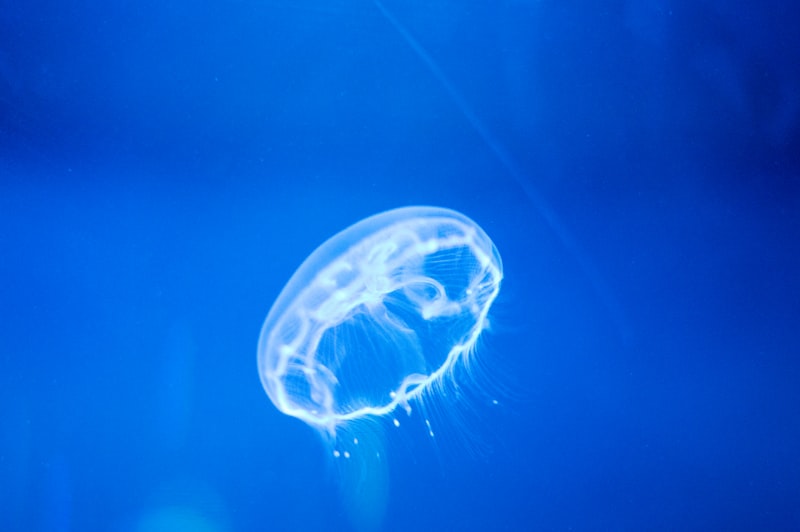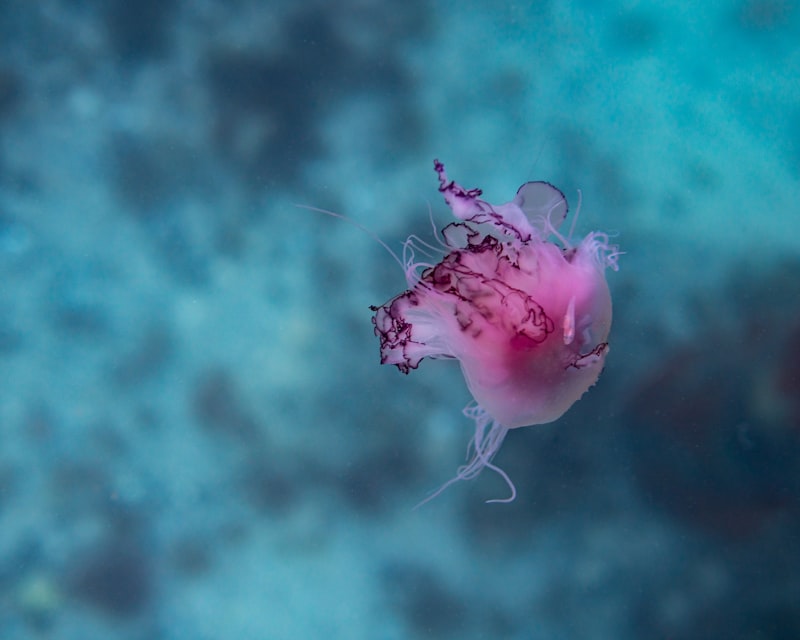One of the most peculiar creatures found in these depths is the anglerfish. Known for its bioluminescent lure dangling from its head, the anglerfish attracts unsuspecting prey in the darkness, making it a true marvel of evolutionary adaptation. Its large mouth and expandable stomach allow it to devour prey much larger than itself in one gulp.
Moving deeper into the abyss, we encounter the gulper eel, aptly named for its enormous jaws and expandable stomach that can engulf prey much larger than its slender body. Its ability to distend its mouth into a gigantic gaping maw is a sight to behold, reminiscent of a creature from a science fiction movie.
Another fascinating resident of the deep sea is the vampire squid. Despite its ominous name, this creature is more of a gentle giant. It sports large, red eyes and webbing between its tentacles, giving it a cloak-like appearance. It uses bioluminescent light to confuse predators and has the unique ability to turn itself inside out to evade capture, revealing its spiky defensive tentacles.
Delving even deeper, the barreleye fish showcases a transparent head filled with fluid, through which its tubular eyes can rotate, allowing it to look upward to spot prey while swimming underneath them. This incredible adaptation helps it navigate the dimly lit waters with ease, despite its otherwise fragile appearance.

The deep ocean is truly a realm of wonders, where evolution has crafted creatures that seem more suited to science fiction than reality. From anglerfish to vampire squid, each inhabitant has its own unique story of survival in the harsh, dark depths. These creatures remind us of the boundless diversity of life on Earth, even in the most extreme and inhospitable environments.
Into the Abyss: Unveiling the Strange Wonders of Deep Sea Creatures
Ever wondered what lies beneath the surface of our oceans? The world below is a mysterious realm, home to some of the most bizarre and fascinating creatures known to man. Join us on a journey into the abyss as we unveil the strange wonders of deep sea creatures.
Picture this: a world where sunlight struggles to penetrate, where darkness reigns and pressure is crushing. In these extreme conditions, life not only survives but thrives in forms that challenge our imagination. Deep sea creatures have evolved unique adaptations to cope with the harsh realities of their environment.
Take the anglerfish, for example. This deep sea dweller sports a bioluminescent lure that hangs in front of its mouth like a fishing pole. It uses this light to attract prey in the pitch-black depths. Imagine being a tiny fish, drawn towards what seems like a guiding star, only to meet your fate in the jaws of a waiting predator.
Or consider the gulper eel, also known as the pelican eel. Its most distinctive feature is its large mouth, which it can open wide enough to swallow prey much larger than itself. Its long, slender body is an adaptation for life in the deep sea, where food is scarce and the ability to catch and consume prey efficiently is crucial for survival.
But it’s not just the predators that capture our imagination. The vampire squid, with its dark red skin and webbed arms, looks like something out of a science fiction movie. Despite its ominous appearance, this creature feeds on marine snow and small crustaceans, using its bioluminescent organs to camouflage itself from predators lurking above.

The deep sea is also home to creatures that defy conventional norms of size and appearance. The giant isopod, resembling an oversized pill bug, can grow up to sizes that seem more suited to prehistoric times than the modern ocean. Found scavenging on the ocean floor, these creatures play a crucial role in the deep sea ecosystem by recycling nutrients back into the food chain.
Exploring the strange wonders of deep sea creatures is a reminder of how little we truly know about our planet’s oceans. Each new discovery sheds light on the incredible diversity and resilience of life on Earth, challenging us to rethink what is possible in the depths below. As scientists continue to explore and study these mysterious creatures, who knows what other marvels of nature await us in the uncharted territories of the deep sea?
Mysteries of the Deep: Bizarre Creatures That Defy Imagination
One such marvel is the anglerfish, a creature known for its bioluminescent lure dangling in front of its mouth. This glowing appendage attracts unsuspecting prey towards its razor-sharp teeth, making it a formidable predator despite its relatively small size. The anglerfish’s ability to generate its own light in the darkness of the abyss is a testament to the ingenuity of evolution.
Moving deeper into the oceanic abyss, we encounter the gulper eel, also aptly named the pelican eel. Its most striking feature is its enormous mouth, which it can unhinge to swallow prey much larger than itself. This deep-sea predator navigates the darkness using its sensitive lateral line system, detecting vibrations and movements of potential meals in the pitch-black waters.
Not all deep-sea creatures are predators; some are masters of camouflage. Take the mimic octopus, for instance. This intelligent cephalopod can change its shape, color, and even behavior to mimic other animals such as lionfish, flatfish, and jellyfish. By imitating its surroundings, the mimic octopus can evade predators and sneak up on prey with astonishing precision.
Venturing even deeper, we encounter the vampire squid, a creature that lives at depths where oxygen levels are extremely low. Despite its ominous name, the vampire squid is harmless to humans, feeding primarily on marine snow—organic debris that gently falls from upper waters. Its unique appearance, with its red eyes and webbed arms, makes it a fascinating subject of deep-sea exploration.
Each of these creatures showcases the wonders and mysteries of the deep ocean, reminding us of how little we truly know about the world beneath the waves. As researchers delve deeper into these uncharted waters, who knows what other astonishing discoveries they will unveil?
Aliens of the Ocean Floor: Discovering the Most Peculiar Deep Sea Creatures
Imagine descending thousands of feet below the surface, where darkness envelops everything and only the dim glow of bioluminescent organisms breaks the monotony. Here, amidst the abyssal plains and hydrothermal vents, you’ll encounter creatures unlike any seen on land.
One of the most peculiar inhabitants of the deep sea is the anglerfish. Sporting a bioluminescent lure dangling from its forehead like a fishing rod, it attracts unsuspecting prey in the darkness. This bizarre adaptation allows it to survive in the nutrient-poor waters where it resides.
Another astonishing creature is the vampire squid. Despite its ominous name, it’s more of a gentle phantom of the deep. With its deep-red color and cloak-like webbing between its arms, it drifts gracefully, using bioluminescent light displays to confuse predators and prey alike.
Moving deeper into the abyss, we encounter the gulper eel, aptly named for its enormous mouth that seems almost disproportionate to its slender body. This creature can engulf prey much larger than itself, adapting to survive in the harsh realities of the deep sea where food is scarce.
One of the oldest living species on Earth, the horseshoe crab, also finds its home in these depths. With its primitive armored body and long tail, it scuttles along the ocean floor, feeding on mollusks and detritus that sink from above.
Each of these creatures has evolved remarkable adaptations to thrive in environments that are alien to us. Their peculiar appearances and behaviors continue to astonish scientists and inspire storytellers, reminding us of the vast diversity of life on our planet, even in the darkest and most remote corners of the ocean.
Beyond the Surface: Journeying into the Realm of Deep Sea Oddities
Imagine plunging into the depths of the ocean, far beyond where sunlight penetrates. This is where the realm of deep sea oddities begins. These creatures inhabit a world that seems almost alien to us, with adaptations that defy imagination.
One of the most bizarre deep sea oddities is the anglerfish. Known for its bioluminescent lure dangling from its head, this fish uses light to attract prey in the darkness. It’s a bit like a deep sea angler using a glowing lantern to lure unsuspecting prey close enough to strike—a truly mesmerizing adaptation.
Then there’s the gulper eel, a creature with a mouth that can open wide enough to swallow prey much larger than itself. Imagine if your mouth could stretch open to engulf something as big as your entire body—it’s a survival strategy that’s as effective as it is eerie.
Moving on to the vampire squid, which isn’t actually a squid or an octopus but something in between. It has glowing eyes and webbing between its arms, giving it a cloak-like appearance. Despite its name, it’s a gentle creature that uses bioluminescence to confuse predators and communicate in the dark depths.
Have you heard of the barreleye fish? Picture a transparent head with its tubular eyes inside, capable of rotating to look directly upward to spot prey or predators above. It’s like having built-in periscopes that can see through its own skull—a true marvel of evolution in the deep sea.
Lastly, the dumbo octopus deserves a mention for its ear-like fins that resemble the famous Disney character. These octopuses gracefully float above the seabed, using their fins to propel themselves with surprising agility.
Exploring the world of deep sea oddities is like uncovering a hidden treasure trove of nature’s most peculiar creations. These creatures remind us of the boundless diversity of life on Earth, where even in the most extreme environments, life finds a way to thrive and astonish us with its sheer ingenuity and adaptability.
Deep Sea Marvels: Fascinating Creatures That Glow, Morph, and Hunt
Imagine encountering a deep-sea jellyfish, its translucent bell gently pulsating with bioluminescent light. These ethereal beings use light-producing chemicals to lure prey or deter predators in the pitch-black depths. Their ability to glow with an otherworldly radiance showcases nature’s ingenious solutions for survival in environments devoid of sunlight.
Not far from the jellyfish, a vampire squid gracefully maneuvers through the water, adorned with velvety, light-emitting organs called photophores. Despite its ominous name, this deep-sea dweller prefers to evade conflict rather than seek blood. Instead, it employs mesmerizing displays of light to confuse threats and disappear into the darkness, a testament to evolution’s capacity for creating marvels from the mundane.
In the shadowy depths, anglerfish embody both horror and fascination with their bioluminescent lures dangling above their toothy maws. These “fishing rods” are biologically engineered to attract unsuspecting prey, illustrating how predatory strategies evolve in isolation from sunlight’s reach. It’s a prime example of nature’s mastery in crafting solutions to the perpetual challenge of finding food in an unforgiving environment.
As we delve deeper into the ocean’s mysteries, each discovery unveils new insights into the resilience and diversity of life forms that call these depths home. From the delicate dance of glowing jellyfish to the stealthy maneuvers of the vampire squid, every encounter with these deep-sea marvels reinforces the wonder of our planet’s ecosystems and the untold stories hidden beneath the waves.
Frequently Asked Questions
What role do deep-sea ecosystems play in the larger marine environment?
Learn about the critical role deep-sea ecosystems play in the marine environment, influencing biodiversity, nutrient cycling, and climate regulation. Discover how these ecosystems support diverse life forms and contribute to global ocean health.
How do scientists study deep-sea creatures that are rarely seen?
Learn how scientists study rarely seen deep-sea creatures using specialized submersibles and remotely operated vehicles (ROVs). They use cameras and sensors to capture images and data, allowing researchers to understand the unique ecosystems and behaviors of these mysterious creatures.
How do deep-sea creatures adapt to extreme pressure and darkness?
Learn how deep-sea creatures adapt to extreme pressure and darkness, exploring their unique physiological features such as bioluminescence and pressure-resistant bodies.
What are bioluminescent organisms, and why are they important in the deep ocean?
Discover what bioluminescent organisms are and why they play a crucial role in the deep ocean ecosystem. Learn about their natural ability to produce light, which aids in camouflage, communication, and attracting prey. Explore the significance of bioluminescence in scientific research, helping scientists understand deep-sea biodiversity and ecological dynamics.
What are some of the strangest creatures found in the deep ocean?
Discover bizarre deep-sea creatures such as the anglerfish with its luminous lure, the eerie gulper eel known for its massive mouth, the transparent barreleye fish with its see-through head, and the ghostly vampire squid that dwells in oxygen minimum zones.



[…] Weird and Wonderful Creatures of the Deep Ocean […]